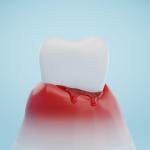Gum tissue, also known as gingival tissue, is a vital component of the oral cavity. It surrounds and supports the teeth, forming a protective barrier against bacteria and trauma. While often overlooked, healthy gum tissue is crucial for maintaining good oral health. This comprehensive article delves into the anatomy, functions, common issues, and best practices for gum tissue care, highlighting its fundamental role in oral well-being.
The Anatomy of Gum Tissue
Gum tissue is a complex structure that plays a pivotal role in the oral cavity. Understanding its anatomy is essential to appreciate its functions and potential problems. Gum tissue consists of the following key components:
- Gingiva
- Periodontal Ligament
- Alveolar Bone
Gingiva
The gingiva, commonly referred to as “gums,” is the visible, pink tissue that surrounds the teeth. It can be categorized into two main parts: the free gingiva and the attached gingiva.
The free gingiva is the part that extends from the crest of the ridge to the gingival margin, forming a collar-like structure.
The attached gingiva is tightly bound to the bone and covers the tooth roots. It helps stabilize and protect the teeth.
Periodontal Ligament
The periodontal ligament (PDL) is a connective tissue that connects the cementum (outer layer of the tooth’s roots) to the alveolar bone. It acts as a cushion and shock absorber, enabling slight tooth movement during chewing.
Alveolar Bone
The alveolar bone is the dense, compact bone that supports the teeth. It provides the foundation for the teeth and is directly affected by the health of the surrounding gum tissue.
The Functions of Gum Tissue
Gum tissue serves several essential functions in the oral cavity:
- Protection
- Attachment
- Sensation
- Nutrient Supply
- Aesthetic Appeal
Protection
The gingiva acts as a protective barrier for the underlying structures, such as tooth roots, nerves, and blood vessels.
It prevents harmful bacteria and foreign objects from entering the bloodstream through the bloodstream.
Attachment
The attached gingiva firmly attaches to the tooth and underlying bone, providing stability and support.
Sensation
Gum tissue contains numerous sensory nerve endings that allow you to detect pressure, temperature, and texture when chewing or consuming hot or cold substances.
Nutrient Supply
Blood vessels in the gum tissue provide a continuous supply of nutrients to the underlying bone and help in tissue repair.
Aesthetic Appeal
Healthy gum tissue contributes to a visually pleasing smile by framing and supporting the teeth.
Common Gum Tissue Issues
Maintaining healthy gum tissue is essential for overall oral health. Several common issues can affect gum tissue:
- Gum Disease (Periodontal Disease)
- Gum Recession
- Gum Infections
- Gum Lesions
- Gum Swelling
- Gum Sensitivity
Gum Disease (Periodontal Disease)
Periodontal disease encompasses conditions such as gingivitis and periodontitis.
Gingivitis is the inflammation of the gums, often caused by poor oral hygiene and plaque buildup.
Periodontitis is a more severe form of gum disease, characterized by the destruction of the supporting structures around the teeth, including the alveolar bone.
Gum Recession
Gum recession is the process of gum tissue gradually pulling away from the teeth, exposing the tooth roots. It can result from periodontal disease, aggressive brushing, or genetics.
Gum Infections
Gum infections can occur due to bacterial or viral agents, leading to conditions such as abscesses and ulcers. These infections can be painful and require prompt treatment.
Gum Lesions
Lesions or sores on the gum tissue can be caused by various factors, including trauma, allergies, or infections. Some lesions may be benign, while others may require medical attention.
Gum Swelling
Swelling of the gum tissue can be a sign of inflammation or infection. It may be accompanied by pain and discomfort.
Gum Sensitivity
Gum sensitivity, often due to exposure of the tooth roots, can lead to discomfort when consuming hot, cold, or sweet foods and beverages.
Maintaining Healthy Gum Tissue
Preventing gum tissue issues and maintaining overall oral health involves a combination of good oral hygiene practices and regular dental care. Here are some key strategies to keep your gum tissue healthy:
- Proper Brushing and Flossing
- Regular Dental Checkups
- Healthy Diet
- Smoking Cessation
- Limit Alcohol Consumption
- Stress Management
- Mouthwash and Antimicrobial Rinses
- Gum Protection During Sports
- Gum Massages
Proper Brushing and Flossing
- Brush your teeth at least twice a day using a soft-bristle toothbrush and fluoride toothpaste.
- Use proper brushing techniques to avoid damaging your gum tissue.
- Floss daily to remove plaque and food particles from between your teeth and along the gumline.
Regular Dental Checkups
- Schedule regular dental checkups, typically every six months, to monitor the health of your gums and teeth.
- Dental professionals can detect gum issues in their early stages and provide appropriate treatment.
Healthy Diet
- A balanced diet rich in fruits, vegetables, and lean proteins can support gum tissue health.
- Avoid excessive consumption of sugary and acidic foods and beverages, which can contribute to gum disease.
Smoking Cessation
- Smoking is a significant risk factor for gum disease and can hinder the healing process.
- Quitting smoking can significantly improve gum tissue health.
Limit Alcohol Consumption
- Excessive alcohol consumption can dehydrate the body, including the gum tissue.
- Limit your alcohol intake to maintain healthy gums.
Stress Management
- High stress levels can weaken the immune system, making you more susceptible to gum infections.
- Practice stress management techniques, such as meditation and deep breathing, to support gum health.
Mouthwash and Antimicrobial Rinses
- Using an antimicrobial mouthwash can help reduce the bacteria in your mouth.
- Consult your dentist for recommendations on the most suitable mouthwash for your specific needs.
Gum Protection During Sports
If you participate in contact sports, wear a mouthguard to protect your teeth and gums from injury.
Gum Massages
- Gently massaging your gums can help improve blood circulation and maintain gum tissue health.
- Consult your dentist for guidance on proper gum massage techniques.
Treating Gum Tissue Issues
If you develop gum tissue issues, it’s essential to seek professional dental care promptly. The treatment options for gum problems vary depending on the severity of the issue:
- Gingivitis
- Periodontitis
- Gum Recession
- Gum Infections
- Gum Lesions
- Gum Swelling
- Gum Sensitivity
Gingivitis
- Early-stage gum disease, gingivitis, is typically treated with improved oral hygiene practices, such as regular brushing and flossing.
- Your dentist may also recommend a professional dental cleaning to remove plaque and tartar buildup.
Periodontitis
- Advanced gum disease (periodontitis) may require more extensive treatment.
- Scaling and root planing, a deep cleaning procedure, can remove bacterial deposits and smooth the tooth roots to prevent further plaque buildup.
- In severe cases, surgical interventions like gum grafts or flap surgery may be necessary to repair damaged gum tissue and bone.
Gum Recession
- Gum recession can be addressed through various procedures, including gum grafts.
- During a gum graft, tissue from one part of the mouth is transplanted to the areas with recession to cover exposed tooth roots.
Gum Infections
- Gum infections, such as abscesses, may require drainage and antibiotic treatment to address the underlying infection.
- If an abscess has formed, your dentist or periodontist may need to drain the pus to alleviate pain and prevent further complications.
Gum Lesions
- The treatment of gum lesions depends on their cause and severity.
- Benign lesions may resolve on their own, but persistent or painful lesions may require professional evaluation and treatment.
Gum Swelling
- Swollen gums may be caused by various factors, including infection, trauma, or underlying health issues.
- Treatment involves addressing the root cause, which may include antibiotics, improved oral hygiene, or managing systemic health conditions.
Gum Sensitivity
- Tooth sensitivity due to exposed tooth roots can be managed with desensitizing toothpaste and fluoride treatments.
- In some cases, gum grafts or other dental procedures may be recommended to cover the exposed roots and alleviate sensitivity.
It’s crucial to follow your dentist’s recommendations and treatment plan for gum issues. Early intervention and proper treatment can prevent complications and restore gum tissue health.
The Connection Between Gum Health and Overall Well-Being
While gum health is often viewed in the context of oral health, it is closely linked to overall well-being. Emerging research has demonstrated the profound connections between gum health and systemic health. Here are some ways gum health can impact your overall well-being:
- Cardiovascular Health
- Diabetes Management
- Respiratory Health
- Pregnancy Outcomes
- Cognitive Health
- Rheumatoid Arthritis
- Immune System Function
Cardiovascular Health
Chronic gum inflammation and periodontal disease have been associated with an increased risk of cardiovascular diseases. Inflammatory substances released in response to gum infections can contribute to the formation of arterial plaques.
Diabetes Management
Gum disease can make it more challenging to control blood sugar levels in individuals with diabetes. Uncontrolled diabetes can, in turn, worsen gum disease, creating a harmful cycle.
Respiratory Health
Bacteria associated with gum disease can be aspirated into the lungs, potentially exacerbating respiratory conditions. Good gum health is crucial for those with asthma, chronic obstructive pulmonary disease (COPD), or pneumonia.
Pregnancy Outcomes
Pregnant women with gum disease may be at a higher risk of complications like preterm birth and low birth weight. Maintaining gum health is essential for both maternal and infant well-being.
Cognitive Health
Some studies suggest a link between gum disease and cognitive decline, including conditions like Alzheimer’s disease. Chronic inflammation and systemic effects of gum disease may contribute to cognitive issues.
Rheumatoid Arthritis
Emerging evidence suggests that individuals with gum disease may be at an increased risk of developing rheumatoid arthritis. Both conditions involve inflammation and the immune system.
Immune System Function
A healthy mouth, including gum tissue, is crucial for overall immune system function. Chronic gum infections can strain the immune system and increase susceptibility to other illnesses.
These interconnections highlight the importance of maintaining good gum health not only for a healthy smile but also for overall well-being. Regular dental checkups and effective oral hygiene practices are essential for reducing the risk of gum disease and its potential systemic effects.
Special Considerations for Gum Tissue
Certain groups of people may have specific considerations when it comes to gum tissue health:
- Children and Adolescents
- Pregnant Women
- Older Adults
- Patients with Chronic Health Conditions
- Smokers and Tobacco Users
Children and Adolescents
Teaching proper oral hygiene practices to children is essential to establish good habits from a young age. Orthodontic treatments, such as braces, can make gum care more challenging, requiring additional diligence.
Pregnant Women
Hormonal changes during pregnancy can make gum tissue more susceptible to inflammation and infection. Expectant mothers should prioritize oral health to reduce the risk of pregnancy complications.
Older Adults
As individuals age, they may be more prone to gum recession and periodontal disease. Regular dental checkups are crucial to monitor and address age-related gum issues.
Patients with Chronic Health Conditions
Individuals with diabetes, cardiovascular diseases, and other chronic health conditions should be particularly vigilant about gum health. Consult with healthcare providers and dentists to develop a comprehensive care plan.
Smokers and Tobacco Users
Tobacco use is a significant risk factor for gum disease and oral cancer. Smokers should strongly consider quitting and seeking support to improve gum health.
Gum Tissue Maintenance at Home
To maintain healthy gum tissue, it’s important to follow a consistent oral hygiene routine at home. Here are some tips for effective gum tissue maintenance:
- Brush Gently
- Floss Daily
- Use Antiseptic Mouthwash
- Stay Hydrated
- Maintain a Balanced Diet
- Limit Alcohol and Tobacco
- Stress Management
Brush Gently
- Use a soft-bristle toothbrush and gentle, circular motions to clean your teeth and gumline.
- Avoid brushing too aggressively, as it can damage gum tissue.
Floss Daily
- Flossing is essential for removing plaque and food particles from between your teeth and along the gumline.
- Proper flossing technique involves gently curving the floss around each tooth in a “C” shape.
Use Antiseptic Mouthwash
- Consider using an antiseptic or antimicrobial mouthwash to reduce the bacterial load in your mouth.
- Consult your dentist for recommendations.
Stay Hydrated
- Drinking plenty of water helps maintain oral moisture and reduces the risk of dry mouth, which can contribute to gum issues.
Maintain a Balanced Diet
- Consume a diet rich in fruits, vegetables, and lean proteins while limiting sugary and acidic foods.
- Nutrient-rich foods support gum tissue health.
Limit Alcohol and Tobacco
Minimize alcohol consumption and avoid tobacco products to reduce the risk of gum disease and oral cancer.
Stress Management
Manage stress through relaxation techniques like meditation and deep breathing, as high stress levels can impact gum health.
Conclusion
Gum tissue, often overlooked in discussions of oral health, plays a critical role in maintaining overall well-being. Understanding its anatomy, functions, and common issues is essential for everyone. By prioritizing gum tissue care through proper oral hygiene practices, regular dental checkups, and a healthy lifestyle, individuals can enjoy a beautiful smile and reduce the risk of gum-related issues that can impact systemic health. Remember that gum health is not just about having a great smile; it’s about promoting a healthy life.





